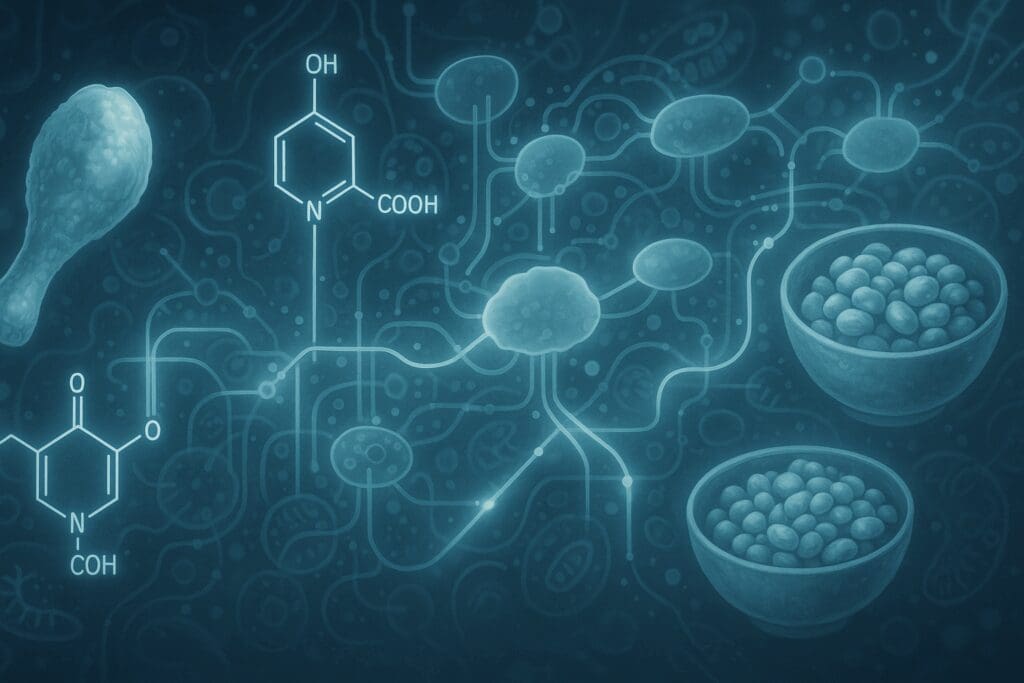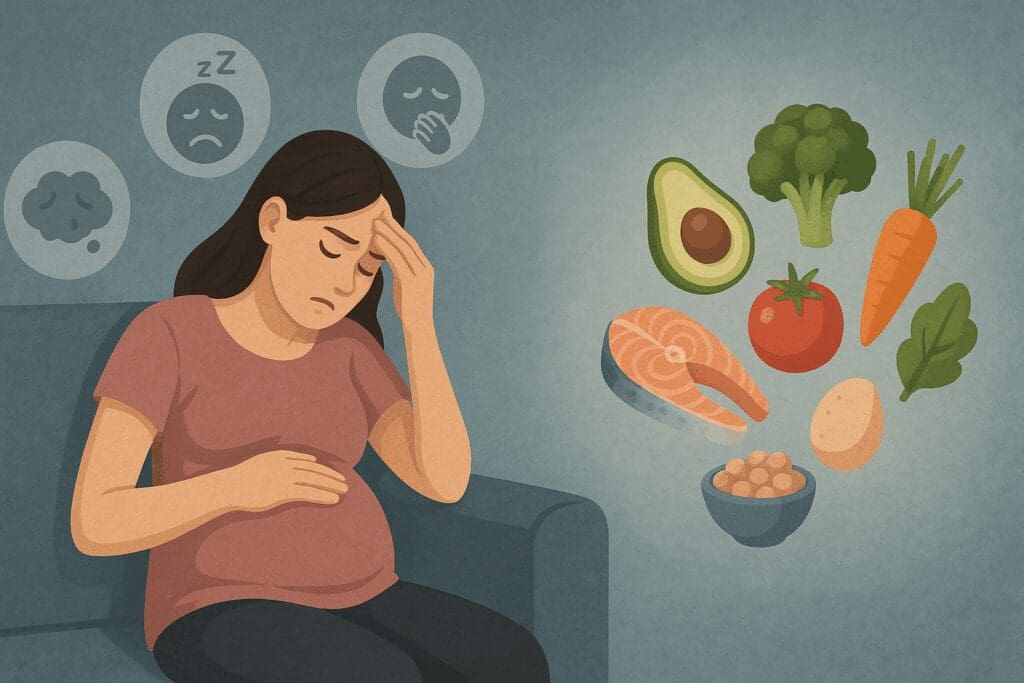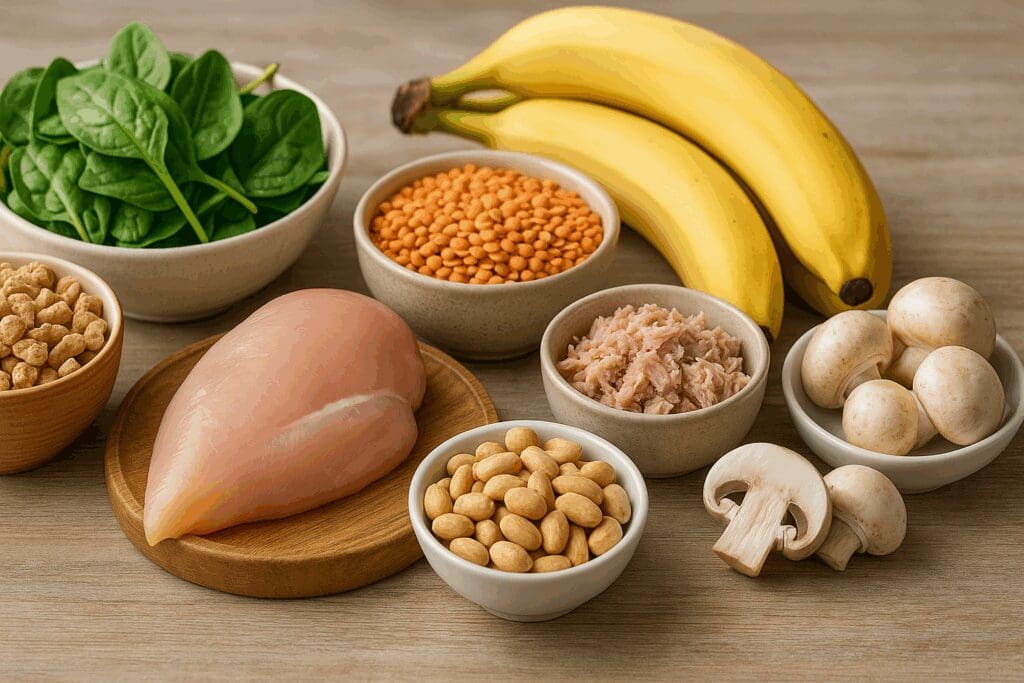Pregnancy marks one of the most transformative and nutritionally demanding periods in a woman’s life. Amid the influx of guidance on prenatal care, the importance of specific micronutrients often becomes buried beneath broader dietary recommendations. Yet certain vitamins hold critical roles that cannot be overstated. Among these, the synergistic functions of niacin vitamin B6 stand out as pivotal to the health of both the mother and her developing baby. Proper intake of these nutrients influences neurological development, energy production, and hormonal balance, making their role in maternal wellbeing an essential consideration in pregnancy nutrition.
You may also like: 7 Vital Reasons to Choose Yogurt for Pregnant Women’s Diet

Understanding Niacin and Vitamin B6: Functions and Interdependence
Niacin, also known as vitamin B3, is a water-soluble vitamin essential for converting food into usable energy. It is involved in over 400 enzymatic reactions in the body, most of which are linked to the metabolism of carbohydrates, proteins, and fats. Niacin exists in several forms, including nicotinic acid and niacinamide, both of which are found in various niacin food sources. Meanwhile, vitamin B6, or pyridoxine, plays a critical role in amino acid metabolism, neurotransmitter synthesis, and immune function. These two nutrients are metabolically interconnected. For example, the enzymatic conversion of tryptophan to niacin requires vitamin B6, illustrating the intricate biochemical harmony between the two.
For pregnant women, these vitamins become even more vital. As the fetus grows and maternal metabolism accelerates, the demand for niacin and vitamin B6 rises accordingly. Not only do these nutrients support cellular energy metabolism and neurological development, but they also help regulate mood and support hormonal changes that can otherwise lead to discomfort or health issues if left unbalanced. The interdependence of niacin and vitamin B6 forms a cornerstone of nutritional health in pregnancy.
Niacin Vitamin B6 and Fetal Development: A Critical Link
The relationship between niacin vitamin B6 and fetal development is not merely theoretical; it is grounded in robust biochemical evidence. Vitamin B6 supports the synthesis of neurotransmitters like serotonin and dopamine, which are critical for brain development. A deficiency in this vitamin during pregnancy has been associated with increased risk of neural tube defects, impaired cognitive function, and emotional dysregulation in infants. Likewise, niacin’s role in DNA repair and gene expression underscores its importance during the rapid cellular division of fetal growth.
Numerous studies have shown that an adequate supply of vitamin B3 can prevent congenital malformations in the cardiovascular and nervous systems. Niacin also helps maintain the structural integrity of the placenta, a critical lifeline for the growing fetus. This is particularly significant considering the increased demand for blood supply and nutrient transfer during pregnancy. Meanwhile, vitamin B6’s involvement in homocysteine metabolism protects against preeclampsia and other complications related to endothelial dysfunction.
The tandem function of niacin and vitamin B6 thus facilitates a protective environment for fetal development. It ensures that the fundamental processes driving embryonic growth—cellular respiration, neurological wiring, hormonal regulation—occur without interruption or compromise. Without a consistent intake of these nutrients, both the short-term outcomes for birth and long-term developmental trajectories could be adversely affected.

Pregnancy-Induced Vitamin Depletion and Nutritional Risk Factors
Pregnancy is a condition characterized by heightened metabolic demand, increased plasma volume, and frequent gastrointestinal changes, all of which contribute to a greater risk of vitamin depletion. The body’s need for niacin and vitamin B6 often exceeds typical dietary intake, especially during the second and third trimesters when fetal growth accelerates. Symptoms such as fatigue, irritability, muscle weakness, and nausea—often dismissed as typical pregnancy complaints—may sometimes signal underlying micronutrient deficiencies.
Vitamin B6, in particular, is water-soluble and not stored in large quantities within the body, meaning it must be consumed regularly. Women with hyperemesis gravidarum, a severe form of morning sickness, are especially vulnerable to B6 deficiency. This condition can result in malabsorption, compounding the risk of insufficient nutrient intake. Niacin depletion, on the other hand, may manifest more subtly through skin inflammation, digestive distress, and cognitive fog—symptoms that can easily go unrecognized in a prenatal context.
Certain populations are at heightened risk of deficiency, including vegetarians, women with poor dietary habits, those with pre-existing medical conditions such as Crohn’s disease, or those taking medications that interfere with vitamin metabolism. Understanding these risk factors allows for timely intervention and tailored nutritional strategies that ensure both maternal and fetal health remain uncompromised.
Niacin Vitamin B6 in Pregnancy Nutrition: How Much Is Enough?
Determining appropriate intake levels of niacin vitamin B6 during pregnancy requires nuanced consideration. According to the National Institutes of Health (NIH), the recommended dietary allowance (RDA) for niacin during pregnancy is 18 mg NE/day, while that for vitamin B6 is 1.9 mg/day. These values are higher than those for non-pregnant women, reflecting the increased physiological demands of gestation. However, individual requirements may vary based on genetic, metabolic, and lifestyle factors.
It’s also important to consider the difference between intake from natural food sources versus supplementation. Foods rich in vitamin B3 and B6 offer a complex matrix of nutrients that support absorption and utilization. Whole food sources of niacin include poultry, fish, fortified cereals, legumes, and seeds. For vitamin B6, excellent options include bananas, potatoes, chickpeas, and fortified grains. Incorporating these into daily meals provides a reliable foundation for meeting RDA targets without excessive reliance on supplements.
Still, supplementation may be necessary in specific cases, such as during periods of increased nausea or poor appetite, where dietary intake is compromised. Prenatal vitamins usually contain a safe dose of these nutrients, but over-supplementation can carry risks. High doses of niacin, for instance, may lead to flushing or liver toxicity, while excessive vitamin B6 intake has been linked to neuropathy. Thus, any use of high-dose supplements should be done under medical supervision.

Dietary Sources and Bioavailability: What Foods Are High in Vitamin B3 and B6?
Understanding what foods are high in vitamin B3 and B6 allows expecting mothers to make informed dietary choices. Niacin is abundant in animal-based proteins, especially turkey, chicken breast, and tuna. These foods contain tryptophan, an amino acid that can be converted into niacin in the presence of vitamin B6. Plant-based sources include peanuts, whole grains, legumes, and fortified cereals, which rank among the foods highest in vitamin B3.
Similarly, foods with vitamin B6 include a variety of both animal and plant-based options. Chicken, beef liver, and salmon are rich in pyridoxine, as are bananas, avocados, and spinach. Niacinamide food sources also include mushrooms, green peas, and fortified plant-based milk. For those seeking a vegetarian or vegan-friendly approach, lentils, tofu, and sunflower seeds can serve as vital staples. The challenge lies not just in eating these foods, but in ensuring consistent consumption that meets pregnancy-specific nutritional benchmarks.
It’s also crucial to understand how cooking methods and food processing affect vitamin retention. Boiling, for instance, can leach water-soluble vitamins like B6, while milling grains can strip away their niacin content. Opting for minimally processed whole foods and utilizing cooking methods that preserve nutrient density—like steaming or roasting—can significantly improve bioavailability. This understanding transforms the act of eating from mere sustenance into a strategic tool for maternal health.

The Emotional and Cognitive Benefits of Niacin Vitamin B6 During Pregnancy
Pregnancy is not only a physical journey but also an emotional and psychological transformation. Hormonal fluctuations can trigger mood swings, anxiety, and depressive symptoms, particularly in women with pre-existing mental health conditions. Niacin vitamin B6 support mental equilibrium by influencing neurotransmitter pathways. Vitamin B6 is essential for synthesizing serotonin and gamma-aminobutyric acid (GABA), both of which help regulate mood, reduce anxiety, and promote restful sleep.
Niacin’s contributions to emotional health are equally noteworthy. Its role in energy metabolism means it supports consistent energy levels throughout the day, which can help combat pregnancy fatigue—a common complaint that can influence emotional well-being. Moreover, some research suggests that niacin may enhance cerebral blood flow, supporting cognitive sharpness and memory retention, especially as the body diverts nutrients toward the developing fetus.
These emotional and cognitive benefits are not ancillary; they are integral to a healthy pregnancy experience. The psychological toll of mood disorders during pregnancy can have lasting impacts, influencing bonding, postpartum recovery, and even the infant’s early development. Ensuring adequate intake of these B vitamins offers a non-invasive, evidence-based strategy to support emotional resilience and cognitive function during this delicate life stage.
Clinical Applications and Evidence-Based Research on Niacin and B6 in Pregnancy
The scientific community has increasingly recognized the necessity of niacin vitamin B6 in pregnancy, leading to a proliferation of clinical studies. One landmark study published in the American Journal of Clinical Nutrition found that women with higher intake of vitamin B6 during pregnancy had significantly lower rates of nausea and vomiting. Another study demonstrated a correlation between niacin intake and reduced rates of congenital malformations, particularly when sourced from whole foods rather than synthetic supplements.
In animal models, niacin deficiency has been linked to birth defects in the spinal cord and brain, particularly when maternal diets were low in both niacin and tryptophan. These findings have prompted further human research examining the role of tryptophan-nicotinamide metabolism in fetal neural development. Meanwhile, vitamin B6 has garnered attention for its potential to prevent preeclampsia and reduce inflammation-related pregnancy complications. Ongoing clinical trials are exploring the optimal dosing protocols for both vitamins across different pregnancy stages and among diverse population groups.
What these studies collectively emphasize is not just the necessity of these nutrients, but also the importance of timing, dosage, and bioavailability. When integrated into prenatal care protocols, niacin and B6 supplementation—alongside targeted dietary counseling—can offer measurable improvements in pregnancy outcomes. This evidence base provides healthcare providers with a strong foundation for recommending these nutrients as part of a comprehensive maternal nutrition strategy.
Preventing and Addressing Deficiencies: Practical Strategies for Pregnant Women
Preventing deficiencies of niacin vitamin B6 requires a proactive, multifaceted approach. First, nutritional education should be prioritized during prenatal visits. Expecting mothers often receive generalized dietary advice, but personalized counseling that focuses on specific nutrients can foster better compliance and awareness. Healthcare providers should assess dietary patterns, socioeconomic status, and cultural practices to develop tailored recommendations that reflect real-world accessibility and preferences.
Second, food-based strategies should be the cornerstone of nutrient acquisition. Creating meal plans that feature niacin b3 rich foods such as grilled chicken, lentils, and whole grains, alongside sources of vitamin B6 like bananas, avocados, and spinach, can make a substantial difference. Simple adjustments—such as choosing whole wheat bread over white or incorporating a boiled egg into breakfast—can elevate micronutrient intake significantly without dramatic lifestyle changes.
Finally, supplements should be used judiciously. While prenatal vitamins are generally safe and effective, they should not replace a nutrient-rich diet. Instead, they should act as a safety net, especially during periods of morning sickness or appetite loss. For women at higher risk—those with gastrointestinal disorders, multiple pregnancies, or restricted diets—medical providers may recommend additional supplementation based on lab work and symptom assessments. Early detection and responsive intervention are key to mitigating the risks associated with these deficiencies.
Niacin Vitamin B6 and Postpartum Recovery: Continuing Nutritional Support
The benefits of niacin vitamin B6 extend beyond childbirth into the postpartum period. After delivery, the body undergoes intense physiological and emotional changes that require ongoing nutritional support. Energy demands remain high due to lactation, tissue repair, and hormonal rebalancing. Vitamin B6 plays a crucial role in synthesizing neurotransmitters that help regulate mood, which is vital in preventing postpartum depression. Meanwhile, niacin supports continued energy metabolism and cellular repair.
Breastfeeding mothers have elevated requirements for both vitamins, as their bodies not only recover from labor but also produce nutrient-rich milk for their newborns. Insufficient intake can result in fatigue, poor concentration, and decreased milk quality. Furthermore, B6 is involved in the synthesis of prolactin, the hormone responsible for milk production. Without adequate B6, lactation efficiency can decline, complicating breastfeeding efforts.
Continuing a nutrient-dense diet postpartum helps to stabilize energy levels, enhance emotional well-being, and support maternal-infant bonding. Integrating foods that have b3 and B6, such as fortified cereals, lean meats, leafy greens, and legumes, into daily meals ensures a smooth nutritional transition from pregnancy to motherhood. In this way, niacin and vitamin B6 emerge not merely as prenatal essentials, but as lifelong allies in women’s health.
Frequently Asked Questions: Niacin Vitamin B6 and Maternal Health
How can niacin vitamin B6 support mental clarity and decision-making during pregnancy?
Niacin vitamin B6 contributes significantly to cognitive performance and psychological resilience, particularly in the second and third trimesters when hormonal fluctuations can affect mental focus. These nutrients help stabilize neurotransmitter production, which in turn enhances brain function and emotional regulation. This biochemical support allows expecting mothers to better handle complex decision-making, multitasking, and the cognitive demands of preparing for birth. For example, B6 supports the synthesis of GABA and serotonin, which improve calmness and reduce overstimulation. When included in a balanced diet, niacin vitamin B6 not only supports fetal development but also helps mothers maintain mental sharpness in emotionally charged or high-responsibility scenarios.
Are there long-term benefits of consuming niacin b3 foods post-pregnancy?
Yes, continuing to consume niacin b3 foods beyond pregnancy can help with postpartum recovery and sustained maternal health. Niacin aids in DNA repair and energy production, which are vital for tissue regeneration after childbirth. Foods that have b3, such as turkey, tuna, and peanuts, promote metabolic balance during lactation and assist in hormone normalization. Furthermore, consistent intake of foods with nicotinic acid may help stabilize postpartum mood swings by supporting adrenal function. Over time, these benefits contribute to a smoother recovery and better resilience against fatigue, which is a common challenge during early motherhood.
What are some lesser-known foods that contain b3 and B6 beneficial for pregnancy?
While most people recognize poultry and legumes as niacin sources, lesser-known options include shiitake mushrooms, fortified nutritional yeast, and tempeh, which are especially valuable for plant-based diets. These niacin b3 rich foods also often contain vitamin B6, providing a double benefit. Fortified non-dairy milk, such as almond or oat milk, can be a reliable addition to ensure vitamin coverage without relying on meat or dairy. In terms of convenience, roasted sunflower seeds and dried apricots are portable, nutrient-dense snacks that help meet daily vitamin 3 b needs. Incorporating such diverse options enhances meal variety while supporting comprehensive maternal nutrition.
Why is it important to pair niacin vitamin B6 with protein intake during pregnancy?
Combining protein with niacin vitamin B6 boosts amino acid metabolism and optimizes nutrient absorption, enhancing overall effectiveness. Protein-rich foods often contain tryptophan, which can be converted into niacin in the body when adequate B6 is present. This conversion ensures that both vitamins are synthesized efficiently, maximizing energy production and cellular repair. For example, pairing grilled chicken (a food rich in vitamin b3 niacin) with quinoa or lentils ensures a steady supply of essential nutrients needed for fetal development and maternal energy. Integrating these combinations into daily meals reinforces nutritional synergy and reduces the risk of deficiencies that can arise from unbalanced diets.
What foods with niacinamide are best for women experiencing morning sickness?
Niacinamide is a form of niacin that is gentler on the digestive system, making it ideal for pregnant women with nausea. Foods with niacinamide such as enriched cereals, soft-boiled eggs, and mashed sweet potatoes are well tolerated and nutrient-dense. These options are not only easy to digest but also contain sufficient B3 and B6 to replenish lost nutrients during vomiting episodes. Adding avocado or rice to these meals provides additional nutritional value without triggering discomfort. Such gentle, balanced meals can help reduce the severity and frequency of morning sickness while keeping vitamin intake consistent.
How can foods high in b3 support healthy skin during pregnancy?
During pregnancy, hormonal changes often lead to skin sensitivity, acne, or dryness. Foods high in b3 such as salmon, peanuts, and brown rice support skin health by enhancing barrier function and improving circulation. Niacin facilitates the repair of damaged tissues and reduces inflammation, which is beneficial for managing stretch marks and skin irritation. Including b3 food sources regularly can also promote collagen production, enhancing skin elasticity and resilience. Moreover, niacin is vitamin b that helps regulate sebum production, reducing the risk of pregnancy-related breakouts.
What role do niacin b3 rich foods play in hormone regulation throughout pregnancy?
Niacin b3 rich foods are instrumental in hormone synthesis, particularly those related to stress, mood, and growth. These foods help modulate cortisol levels, reducing anxiety and fatigue, which are common during late pregnancy. Niacin in food supports the adrenal glands, while vitamin B6 aids in the production of progesterone, a hormone critical for maintaining pregnancy. Incorporating sources of vitamin b3 like tuna, mushrooms, and fortified cereals ensures a steady hormonal balance. When consumed consistently, these nutrients contribute to smoother emotional transitions and reduce the risk of hormonal imbalances postpartum.
Why should expecting mothers understand what foods are high in vitamin b3 for meal planning?
Meal planning with knowledge of what foods are high in vitamin b3 ensures that dietary intake remains aligned with the increasing demands of pregnancy. Foods like turkey, green peas, and fortified oats not only deliver essential B3 but also integrate well into varied meal plans. Awareness of these foods simplifies grocery shopping and meal preparation, making it easier to avoid nutritional gaps. Additionally, knowing what foods have b3 niacin allows expecting mothers to balance their macronutrient intake with micronutrient density. This strategic approach supports consistent energy levels, immune resilience, and overall prenatal health.
What cultural or traditional dishes are naturally rich in niacin food sources?
Many global cuisines incorporate traditional dishes naturally rich in niacin food sources. For instance, Latin American diets often feature black beans and corn tortillas, both foods with vitamin b3 when nixtamalization is used. Southeast Asian meals commonly include fermented soy products and fish, both excellent niacin b3 foods. In Mediterranean diets, grilled sardines, whole wheat bread, and eggplant offer balanced sources of vitamin 3 b and B6. These culturally rooted meals not only enhance flavor diversity but also contribute meaningfully to daily vitamin needs, making them valuable additions to pregnancy meal plans.
How can modern food preparation methods preserve sources of vitamin b3 and B6?
Modern cooking techniques play a crucial role in preserving the nutritional integrity of sources of vitamin b3 and B6. Steaming and baking are preferable to boiling, which can leach water-soluble vitamins like B6 into cooking water. Using minimal heat or incorporating raw elements, such as fresh fruits or lightly steamed vegetables, helps maintain nutrient density. Additionally, sprouting grains or fermenting legumes can enhance the bioavailability of both niacin and B6. Choosing whole, unrefined foods and minimizing overcooking are practical strategies that ensure foods rich in vitamin b 3 retain their health-promoting properties throughout pregnancy.
Conclusion: Embracing the Lifelong Benefits of Niacin and Vitamin B6
Niacin vitamin B6 form a dynamic nutritional duo with profound implications for pregnancy nutrition and maternal wellbeing. From supporting fetal brain development and energy metabolism to enhancing emotional health and facilitating postpartum recovery, their influence is both expansive and essential. Understanding what foods contain vitamin b3 and how to incorporate them alongside B6-rich options into daily meals is a powerful act of preventative healthcare.
Throughout pregnancy and beyond, these nutrients serve as biochemical gatekeepers, safeguarding neurological integrity, hormonal balance, and immune resilience. By choosing foods with nicotinic acid and prioritizing niacinamide food sources, mothers can optimize their health and give their children the best possible start. This commitment to nutritional excellence should not be limited to the prenatal period. Rather, it should be embraced as a long-term strategy for lifelong vitality.
In an era where nutritional misinformation is rampant, the evidence-based benefits of niacin vitamin B6 stand out as a beacon of clarity. They remind us that maternal health is not merely the absence of disease, but the presence of nourishment, resilience, and intentional care. For every expecting mother, this knowledge is not just informative—it is empowering.



